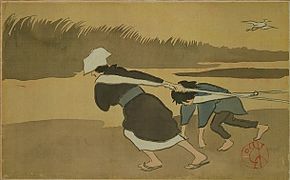Asai Chu
Asai Chū ( Japanese 浅井 忠 ; born June 21, 1856 in Edo , today Tokyo ; † December 16, 1907 in Kyoto ) was a Japanese painter . He is considered the most famous landscape painter of the Yōga , the painting of the Meiji period influenced by Western art .
Life
Asai Chū was the son of a samurai of the Sakura, a clan in Edo. He was trained as a painter in the style of the traditional Kachōga , the bird-and-flower painting. However, he changed his technique, switched to oil painting and was accepted in 1875 at the Shōgidō private painting school founded by Kunisawa Shinkurō . Kunisawa Shinkurō had completed his painting training in London with the painter John Wilcolm and wanted to spread his knowledge through the Yōga school. In 1876 he went to the Kobu Bijutsu Gakko , the Technical Fine Arts School , founded in the same year , and became a student of the Italian Antonio Fontanesi . After he left school in 1878, Asai Chū and ten other students of the Italian founded the Jūichikai association , the group of eleven .
In the following decade, there was an increased disinterest in yoga and, above all, the painters of Nihonga , modern Japanese painting on a traditional basis, became known. It was not until the 1880s that Yoga's interest was renewed through the return of several artists who had learned and studied in Europe and now incorporated this knowledge into Japanese art. Asai Chū's earliest landscape paintings were created around 1888, including Fields in Spring (1888) , which is exhibited today in the Tokyo National Museum . In 1889 he was one of the founders of the Meiji Bijutsukai , an artists' association that later became the Taiheiyō Gakai (Pacific Society for Painting) and was Japan's first artist organization for Western-influenced art. In 1893 the painter Kuroda Seiki returned from Paris and brought the ideas of impressionism and plein-air painting to Japan. Due to this innovation, the yoga artists split into a conservative and a progressive camp. In 1898 Asai Chū was appointed to the Tōkyō Bijutsu Gakkō , today's Tokyo National University of Fine Arts and Music , where Kuroda Seiki also taught. Asai became a representative of the conservative yoga in this position, although he also took impressionist influences on some pictures.
In 1899 Asai Chū got a scholarship from Mombushō, the Japanese Ministry of Education, to study painting in France. Accordingly, he traveled to Europe from 1900 to 1902, commuting between Paris and the suburb of Grez-sur-Loing , which he captured in his painting Autumn in Grez-sur-Loing (1901, National Museum Tokyo). He also traveled to Italy, Germany and England and only then returned to Japan, where he accepted a teaching position at the newly founded Kyōtō Kōtō Kōgei Gakkō (Kyoto School of Design). This made him the first official teacher of Yōga in the culturally very conservative city of Kyoto , from which the style then spread across western Japan. In 1903 Asai opened his own private school in Kyōto, which he called Shōgoin Yōga Kenkyūjo (Shōgo Institute of Western Art) and from which in 1905 the Kansai Bijutsuin (Kansai Art Institute) emerged. His most famous students were Ishii Hakutei , Yasui Sōtarō and Umehara Ryūzaburō . In addition to his painting, he was also active as a book illustrator for woodcut templates , in particular the Tōsei fūzoku gojūban uta awase ( Collected poems of fifty views of Western manners ) , published in 1907, the year he died .
Image selection
- ↑ This picture was shown at the exhibition Japanese Painting in Western Style 1985 in the Museum for East Asian Art in Cologne.
literature
- Aya Louisa McDonald: Asai Chū , Grove Art Online , Oxford University Press 2007; Access required.
- Japan Foundation (Ed.): Japanese Painting in the Western Style, 19th and 20th Centuries. Exhibition catalog, Cologne, 1985.
Web links
| personal data | |
|---|---|
| SURNAME | Asai, Chu |
| ALTERNATIVE NAMES | 浅井 忠 (Japanese) |
| BRIEF DESCRIPTION | Japanese painter |
| DATE OF BIRTH | June 21, 1856 |
| PLACE OF BIRTH | Edo , today Tokyo |
| DATE OF DEATH | December 16, 1907 |
| Place of death | Kyoto |







